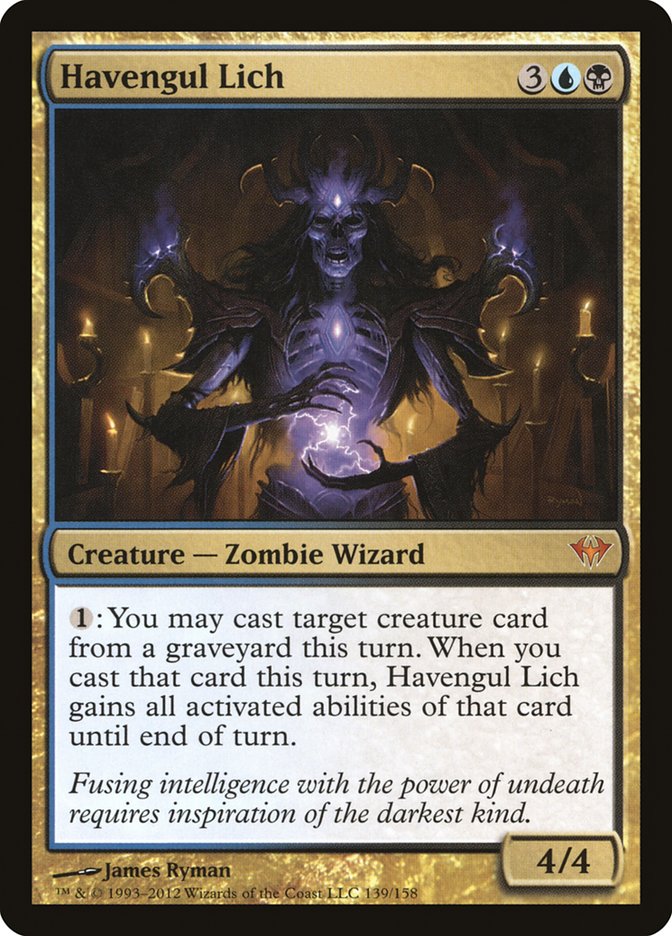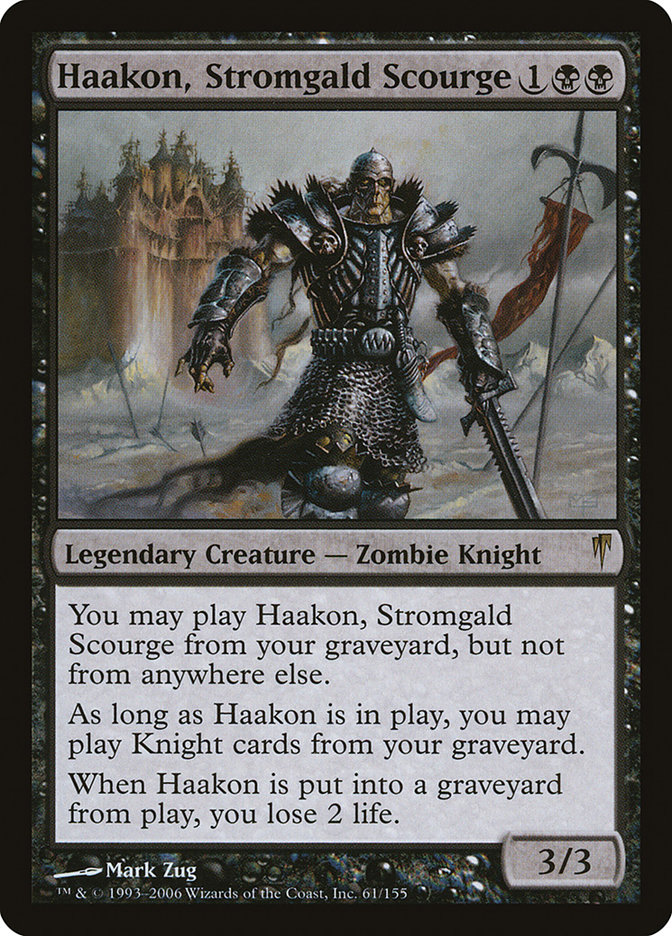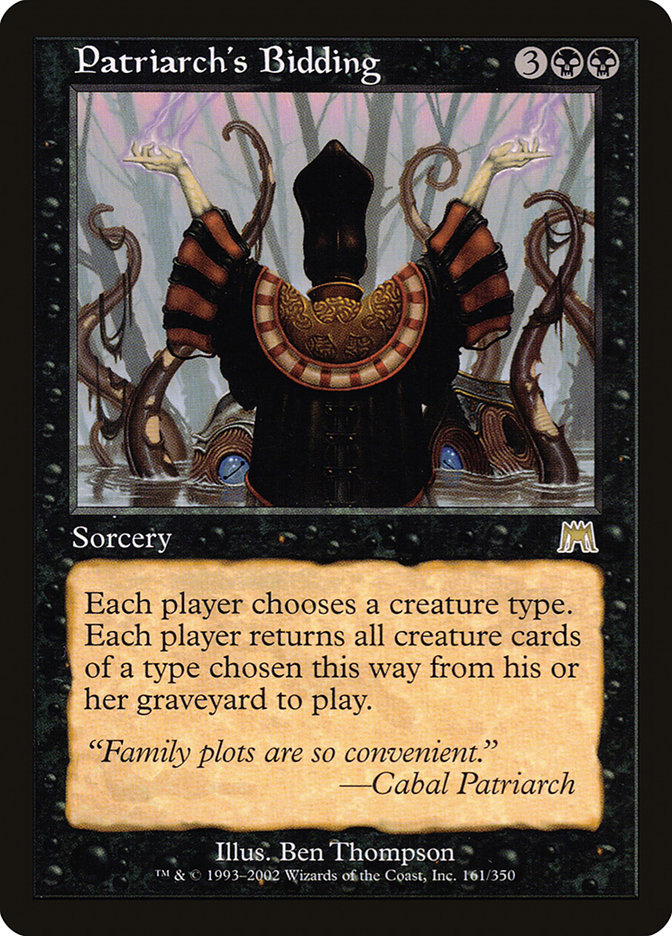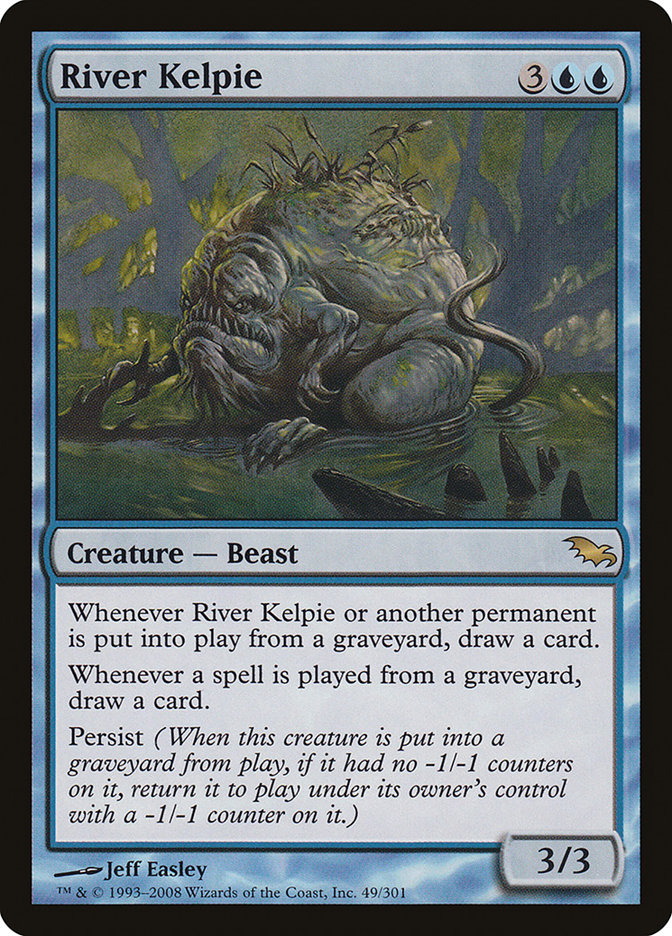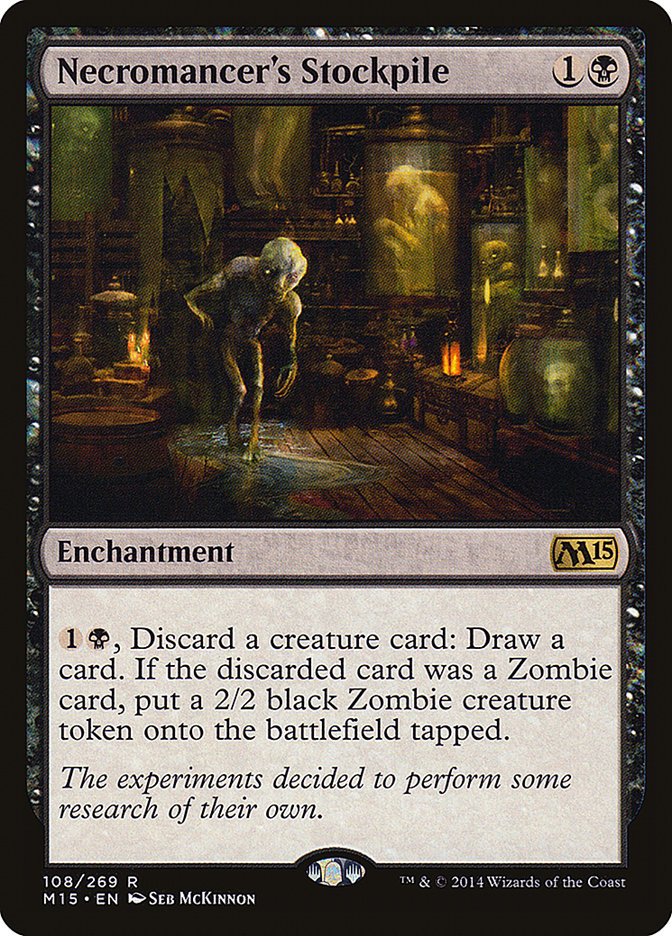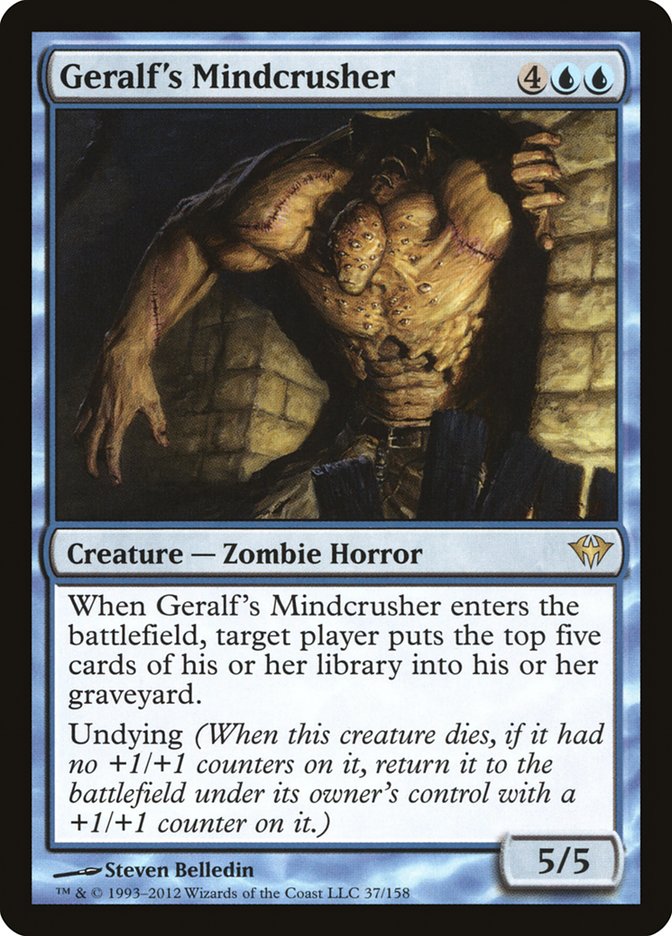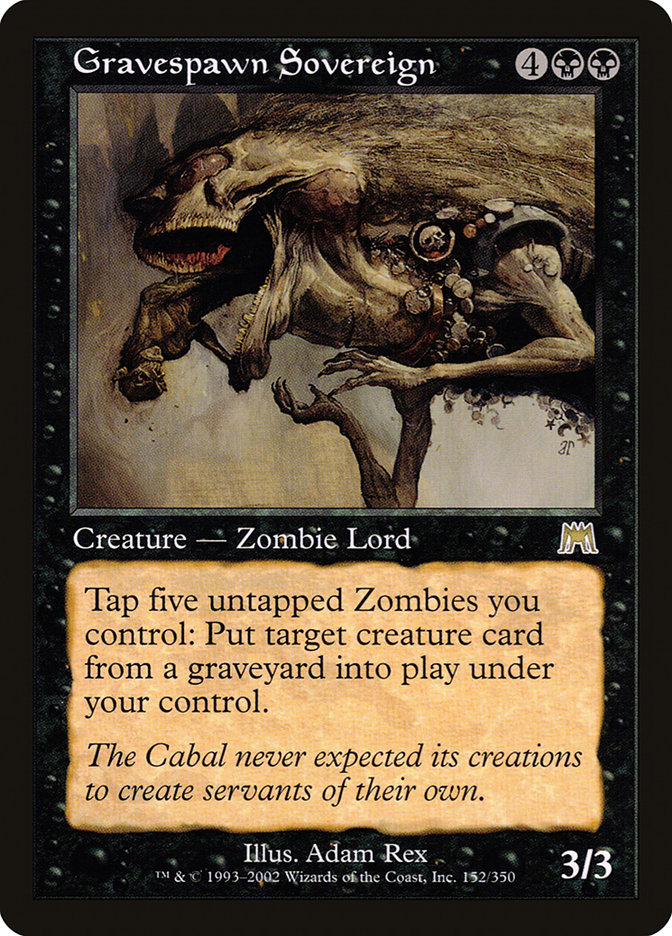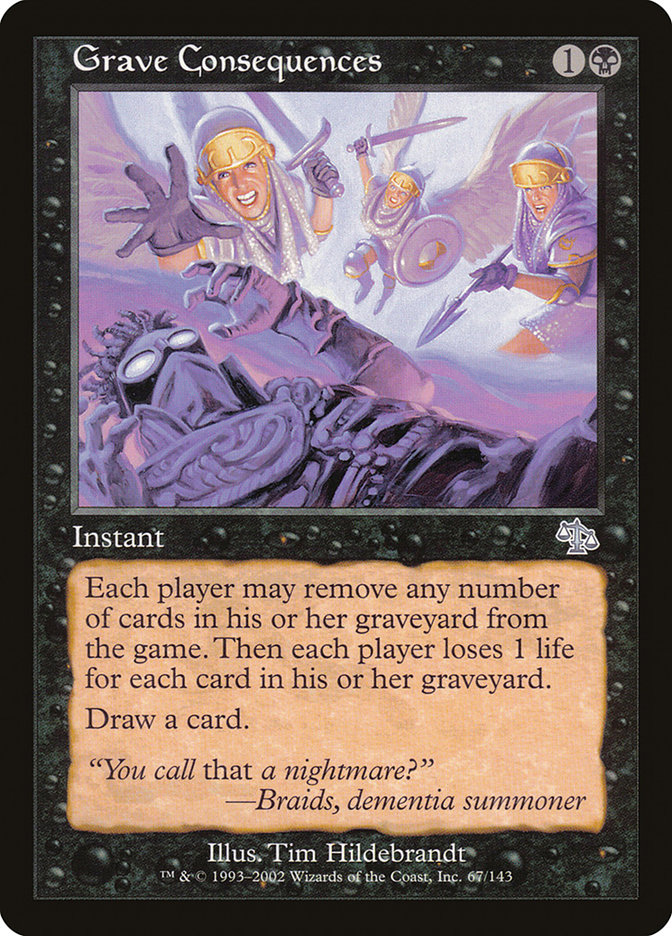Like the cast of The Walking Dead, the players trying to get to the Helipad, and Jane Austen fans, I find that, in Magic, there are simply too many Zombies. Not in the “I’m going to go get a shotgun or a chainsaw” way. I’m not going to go all Angel of Glory’s Rise and try to get rid of them all; I’m going to use them. In a side-step of the Do Over Project, I’m going to split up the Zombies into two different decks, which do two different things with said Zombies.
One of the first decisions to make was to whether to simply split the cards into two Lord of Tresserhorn decks or to use a different commander for the second one. The choice was made simpler by the advent of Gisa and Geralf out of Eldritch Moon, which does exactly one of the things I want to do—namely, cast cards from the graveyard. Additionally, making a deck with Gisa and Geralf frees me up to make a Lord of Tresserhorn Do-Over down the road (minus any Zombies—maybe Assassins of Tresserhorn or something).
The way I approached this split was to look at the cards in the existing Lord of Tresserhorn deck which do the things I want to do in Gisa and Geralf and then port them over. I then filled in the empty slots on both decks, keeping in mind the basic themes of getting Zombies out of the graveyard in the first and making swarms of Zombies in the second. A few decision trees popped up along the way, like which deck got the creatures which buffed the other Zombies and which deck got the big reanimators such as Patriarch’s Bidding and Living Death. Obviously, all the Geralf cards went along with their namesake. Let’s take a look at how it all worked out.
Zombie Deck 1 (Gisa and Geralf): My Graveyard Is My Hand
Deck 1 wants to cast cards from the graveyard and do a bit of other recursion. The self-mill and graveyard use are primary, as opposed to Deck 2, in which the graveyard use is secondary. Process-wise, I first looked at all the cards from the old Lord of Tresserhorn deck which fit the theme, put them on the list, and built from there. Here’s the list:
Creatures (34)
- 1 Zombie Master
- 1 Coffin Queen
- 1 Western Paladin
- 1 Eastern Paladin
- 1 Corpse Harvester
- 1 Dakmor Ghoul
- 1 Ashen Ghoul
- 1 Crypt Creeper
- 1 Haakon, Stromgald Scourge
- 1 Geth, Lord of the Vault
- 1 Phyrexian Crusader
- 1 Vengeful Pharaoh
- 1 Undead Alchemist
- 1 Unbreathing Horde
- 1 Gravecrawler
- 1 Havengul Lich
- 1 Geralf's Messenger
- 1 Geralf's Mindcrusher
- 1 Blood Scrivener
- 1 Liliana's Reaver
- 1 Siren of the Silent Song
- 1 Returned Reveler
- 1 Drakestown Forgotten
- 1 Ghoulcaller Gisa
- 1 Stitcher Geralf
- 1 Risen Executioner
- 1 Liliana, Heretical Healer
- 1 Relentless Dead
- 1 Diregraf Colossus
- 1 Prized Amalgam
- 1 Stitched Mangler
- 1 Laboratory Brute
- 1 Gavony Unhallowed
- 1 Plague Belcher
Planeswalkers (1)
Lands (37)
Spells (27)
- 1 Fellwar Stone
- 1 Darksteel Ingot
- 1 Patriarch's Bidding
- 1 Oversold Cemetery
- 1 Tombstone Stairwell
- 1 Fact or Fiction
- 1 Memory Plunder
- 1 Rise from the Grave
- 1 Manalith
- 1 Cellar Door
- 1 Ghoulcaller's Chant
- 1 Grimoire of the Dead
- 1 Secrets of the Dead
- 1 Chromatic Lantern
- 1 Cyclonic Rift
- 1 Waste Not
- 1 Necromancer's Stockpile
- 1 Necromantic Selection
- 1 Tainted Remedy
- 1 Dread Summons
- 1 Corpse Churn
- 1 Epiphany at the Drownyard
- 1 From Under the Floorboards
- 1 Liliana's Indignation
- 1 Cemetery Recruitment
- 1 Fortune's Favor
- 1 Liliana's Mastery

I ported eighteen cards from the existing Lord of Tresserhorn deck to Gisa and Geralf:
Two cards, False Cure and Read the Runes, went out of Lord of Tresserhorn but didn’t go back into either deck. I’m sure I’ll find homes in other decks for both cards, which I like a great deal.
The deck hinges around its commander, their cousin Havengul Lich, and everyone’s weird uncle, Haakon, Stromgald Scourge. Due to the recent changes in the Commander rules, which allow you to produce mana of any color (not just those in your commander’s color identity), Havengul Lich gets a little stronger. Now you can theoretically cast any creature card from someone else’s graveyard, not just artifacts and those you share colors with. Sure, Solemn Simulacrum is still a great target, but you now have more options.
The idea of this deck made me wonder if a Sen Triplets Zombie deck was the right idea. To some extent, I feared the white component would water down the deck a bit. Add that I am more interested in casting my own things (Havengul Lich can target a card in your own graveyard) than yours, and the choice was obvious. Haakon led me to a few Zombie Knights, like Eastern Paladin and Western Paladin, which will help with some creature control. Unfortunately, you can only cast Knight creature cards from your own graveyard. Still, killing them with a Paladin and then using Havengul Lich is a reasonable option. The other Zombie Knight making the final cut is Phyrexian Crusader, although Marauding Knight, Order of Yawgmoth, and Stromgald Crusader were all in late drafts.
One of the other hinge cards in the deck is River Kelpie. There two major things to note here. First is that River Kelpie triggers when any card from any player enters the battlefield from a graveyard. If you resolve Patriarch’s Bidding with River Kelpie on the battlefield, you’re going to draw a pile of cards. If another player has Sheoldred, Whispering One working, you’ll draw a card every time that player reanimates a creature.
With all the persist and undying shenanigans running around, you’re going to net quite a few cards off of River Kelpie. There is certainly an argument for putting more undying or persist cards into the deck, which is why I made a late swap and put Mikaeus, the Unhallowed into this deck instead of the other one.
The second thing is that if you use Gisa and Geralf or Havengul Lich to cast a card from a graveyard, only River Kelpie’s second ability will trigger. The first ability doesn’t trigger because the first thing you do when you announce a spell is move it to the stack (rule 601.2). The resulting card will enter the battlefield from the stack, not the graveyard. While it would be great to get double duty out of River Kelpie, that’s not the way it works. Nonetheless, you’ll get plenty of mileage out of it. Prized Amalgam combos with River Kelpie as well, giving you an additional card when River Kelpie triggers (assuming it’s in your graveyard, although not until the end step).
A number of self-mill and discard elements let the deck what it wants to. Necromancer’s Stockpile is a nice tool to both get Zombies and not lose whatever you’re discarding, since you can just cast it from the graveyard. It will also help fuel Tombstone Stairwell. The other self-mill elements, such as Geralf’s Mindcrusher and Returned Reveler, also fuel Tombstone Stairwell and give you new casting options.
Thematically, it was necessary to put the Geralf’s cards and Ghoulcaller Gisa into the deck. Unfortunately, Stitcher Geralf simply didn’t make the cut. I didn’t want to run the risk of being forced to exile my own creatures. In a four-player game, assuming everyone runs one-third creatures (which is probably too high—I know 33 creatures isn’t unusual for me, but other players in my local environment aren’t quite that creature-heavy), we’d get on average four creatures from an activation. It just didn’t seem worth the risk. Perhaps as I play the deck some, I might make the choice to sacrifice a little playability for better theme, but we’ll see. You’ll note that Stitcher Geralf stayed in the original Lord of Tresserhorn, since I care a little less about specifically which Zombies are around.
Because this isn’t a Do-Over deck, it wouldn’t violate any self-imposed rules to have some of the same cards in the deck, but I went with the spirit of things and didn’t repeat anything, even down to the lands. You’ll notice a number of lands (plus a few artifacts) which produce any color of mana. They’re in the deck because of Havengul Lich, giving me the opportunity to cast someone else’s bomby creatures.
Zombie Deck 2 (Lord of Tresserhorn): Makin’ Zombies
This is the more straightforward of the two decks. It casts Zombies, battles with them (hopefully larger than originally), and then makes life difficult for opponents by either hurting them when the Zombies go away (Diregraf Captain and Vengeful Dead) or putting giant swarms of Zombies onto the battlefield with Army of the Damned or Zombie Apocalypse.
Creatures (43)
- 1 Withered Wretch
- 1 Gravedigger
- 1 Undead Gladiator
- 1 Soulless One
- 1 Graveborn Muse
- 1 Undead Warchief
- 1 Lord of the Undead
- 1 Vengeful Dead
- 1 Twisted Abomination
- 1 Nefashu
- 1 Noxious Ghoul
- 1 Gempalm Polluter
- 1 Shepherd of Rot
- 1 Gravespawn Sovereign
- 1 Rank and File
- 1 Grave Defiler
- 1 Phyrexian Delver
- 1 Grotesque Hybrid
- 1 Helldozer
- 1 Crypt Champion
- 1 Death Baron
- 1 Lich Lord of Unx
- 1 Jhessian Zombies
- 1 Deathbringer Thoctar
- 1 Anathemancer
- 1 Cemetery Reaper
- 1 Grave Titan
- 1 Skinrender
- 1 Grimgrin, Corpse-Born
- 1 Mikaeus, the Unhallowed
- 1 Diregraf Captain
- 1 Wight of Precinct Six
- 1 Lifebane Zombie
- 1 Gray Merchant of Asphodel
- 1 Tymaret, the Murder King
- 1 Nekusar, the Mindrazer
- 1 Sidisi, Undead Vizier
- 1 Rakshasa Gravecaller
- 1 Corpse Augur
- 1 Forgotten Creation
- 1 Cryptbreaker
- 1 Lord of the Accursed
- 1 The Scarab God
Planeswalkers (1)
Lands (36)
- 13 Swamp
- 1 Mountain
- 2 Island
- 1 Tainted Peak
- 1 Tainted Isle
- 1 Unholy Grotto
- 1 Maze of Ith
- 1 Forgotten Cave
- 1 Barren Moor
- 1 Watery Grave
- 1 Steam Vents
- 1 Blood Crypt
- 1 Ghost Quarter
- 1 Crumbling Necropolis
- 1 Reliquary Tower
- 1 Dragonskull Summit
- 1 Drowned Catacomb
- 1 Akoum Refuge
- 1 Jwar Isle Refuge
- 1 Bojuka Bog
- 1 Desolate Lighthouse
- 1 Opal Palace
- 1 Myriad Landscape
Spells (19)
- 1 Nevinyrral's Disk
- 1 Living Death
- 1 Grave Pact
- 1 Shriveling Rot
- 1 Grab the Reins
- 1 Deadapult
- 1 Agonizing Demise
- 1 Damnation
- 1 Command Tower
- 1 Rooftop Storm
- 1 Endless Ranks of the Dead
- 1 Army of the Damned
- 1 Zombie Apocalypse
- 1 Gravepurge
- 1 Gem of Becoming
- 1 Rakdos Charm
- 1 Empty the Pits
- 1 Monastery Siege
- 1 Dark Salvation

Even though it lost eighteen cards, this is more of an update and an overhaul. The deck pretty much does the same thing that it used to do, only with some different Zombies. I returned to some older choices, like Rank and File, Nefashu, and Crypt Champion, out of a sense of nostalgia. Lord of Tresserhorn was my second major deck, so I wanted to add some cards from elder days.
There are two cards in the deck, one being Crypt Champion and the other being Anathemancer, which I would have preferred to have in the Gisa and Geralf deck, since they seem a better fit thematically, but color identity won’t allow it. One of the reasons I feel safe with Crypt Champion is Noxious Ghoul. It’s likely that whatever my opponents bring back onto the battlefield will die to the Noxious Ghoul trigger from whatever I put back. Gravespawn Soverign is another nod to the olden days of the Zombie decks, when we paid six mana for 3/3s that sometimes do stuff.
The deck rolls over to good graveyard hate (as does Gisa and Geralf, to some extent), but I modeled it on a “(un)life is short” idea. Either we’re going to (repeatedly) get a pile of Zombies onto the battlefield and kill everyone before they get to the chopper, or we’re going to go down in flames. The big spells like Army of the Damned could help some. Either way, the deck perfectly captures the old-school, George Romero movie Zombies theme. I know from experience that it’s fun to play, when it works it works, and when it doesn’t it doesn’t—and that’s perfectly fine with me.
This Week’s Hidden Gem: Grave Consequences
There are lots of Magic cards many of us have either never heard of or have completely forgotten. Especially when I do some research on which cards to put into theme decks, I run across tons of them. This is the first in what I plan to be a weekly feature of finding those Hidden Gems (which I’ve done an entire piece on before, more than once) and showing them to you.
This week’s find, which obviously came from a Gatherer search on “grave,” is Grave Consequences, an uncommon from Judgment. It offers everyone a ghoulish choice—to keep the cards in their graveyards or pay some life. Even if players keep just a few key cards, you’ve drained away well more life than the 1B mana cost would normally buy you. If you’re playing it in a lifegain deck of some kind, then you might not even care about losing the life. It can be especially dangerous in a mill deck, when you’ve put a good part of someone’s library into their graveyard. The best time to cast it is probably when another player has the trigger of Ulamog, the Infinite Gyre or Kozilek, Butcher of Truth on the stack. Clearly, they’re going to pay the one life for their Eldrazi, but then they’ll have to make some difficult choices on what actually gets shuffled back in. This might backfire if their library is small enough, but I’m willing to take the risk.
Add to all of this that it replaces itself.
Remember that the earlier in the game you draw additional cards, the more valuable each of those cards are. If Grave Consequences is in your opening hand, you might consider just getting the card off of it early instead of leaving it in your hand the whole game, waiting for the big blowout moment. You might also lull people into losing a few life, since their life totals are higher. At 40, even five or six life is no big deal. All in all, it’s a great little find.
Last Week’s Comments
In the discussion of my Hall of Fame ballot, there was some disagreement on my stance on Saito. Chris Harrington writes,
“If Saito is cleared to do everything else it seems petty to say he’s NEVER going to get your vote. For the most part Hall-of-Fame voting is about making a case for personal friends, it definitely would be in already if the player base wasn’t mostly westerners.”
Chris seems to be making a big leap from “cleared to do everything else” to being in the Hall of Fame. I’m not suggesting that he not be allowed to play Magic; he’s earned that privilege (and playing Magic in sanctioned events is a privilege, not a right) by serving his suspensions. I’m stating that a two-time convicted cheater should not be given the game’s highest honor. That’s hardly petty. I also summarily reject Chris’s notions of both HoF voting being about making a case for personal friends and Western bias regarding the Hall. They’re easy shots to take, and while both may have happened in the past, they’re certainly not systemic.
Lee Steht sees the issue differently, simply stating,
“Wish others would be that hard on cheaters…”
I firmly believe that in order to prevent offenses, the punishment for getting caught must exceed the reward for getting away with them. If all we have is proportionate response, then the EV for the potential cheater is too high for said response to serve as a deterrent. This is why I advocate long suspensions as well as a third strike rule.
This Week’s Deck Without Comment: Aurelia Goes to War
Creatures (39)
- 1 Solemn Simulacrum
- 1 Northern Paladin
- 1 Southern Paladin
- 1 Godo, Bandit Warlord
- 1 Weathered Wayfarer
- 1 Order of the Sacred Torch
- 1 Marton Stromgald
- 1 Viashino Heretic
- 1 Crusading Knight
- 1 Knight of Meadowgrain
- 1 Mirror Entity
- 1 Kinsbaile Cavalier
- 1 Balefire Liege
- 1 Duergar Hedge-Mage
- 1 Figure of Destiny
- 1 Knight of the White Orchid
- 1 Knight-Captain of Eos
- 1 Serra Ascendant
- 1 Knight Exemplar
- 1 Sun Titan
- 1 Mirran Crusader
- 1 Hero of Bladehold
- 1 Hero of Oxid Ridge
- 1 Grand Abolisher
- 1 Mentor of the Meek
- 1 Thalia, Guardian of Thraben
- 1 Hellrider
- 1 Silverblade Paladin
- 1 Gisela, Blade of Goldnight
- 1 Odric, Master Tactician
- 1 Firemane Avenger
- 1 Foundry Champion
- 1 Frontline Medic
- 1 Legion Loyalist
- 1 Boros Reckoner
- 1 Hushwing Gryff
- 1 Hixus, Prison Warden
- 1 Anya, Merciless Angel
- 1 Hanweir Garrison
Planeswalkers (1)
Lands (11)
Spells (48)
- 14 Plains
- 1 Land Tax
- 10 Mountain
- 1 Goblin Bombardment
- 1 Akroma's Vengeance
- 1 Sword of Light and Shadow
- 1 Sword of Fire and Ice
- 1 Skullclamp
- 1 Wayfarer's Bauble
- 1 Tithe
- 1 Ruination
- 1 War Cadence
- 1 Boros Signet
- 1 Return to Dust
- 1 Planar Cleansing
- 1 Chain Reaction
- 1 Marshal's Anthem
- 1 Sword of War and Peace
- 1 Martyr's Bond
- 1 Blasphemous Act
- 1 Faith's Reward
- 1 Vandalblast
- 1 Boros Charm
- 1 Assemble the Legion
- 1 Order
- 1 Dragonrage

Check out our comprehensive Deck List Database for lists of all my decks:
SIGNATURE DECKS
Purple Hippos and Maro Sorcerers; Kresh Into the Red Zone; Halloween with Karador; Dreaming of Intet; You Did This to Yourself;
THE CHROMATIC PROJECT
Mono-Color
Heliod, God of Enchantments; Thassa, God of Merfolk; Erebos and the Halls Of The Dead; Forge of Purphoros; Nylea of the Woodland Realm; Karn, Beatdown Golem
Guilds
Lavinia Blinks; Obzedat, Ghost Killer; Aurelia Goes to War; Trostani and Her Angels; Lazav, Shapeshifting Mastermind; Zegana and a Dice Bag; Rakdos Reimagined; Glissa, Glissa; Ruric Thar and His Beastly Fight Club
Shards and Wedges
Adun’s Toolbox; Animar’s Swarm; Karrthus, Who Rains Fire From The Sky; Demons of Kaalia; Merieke’s Esper Dragons; Nath of the Value Leaf; Rith’s Tokens; The Mill-Meoplasm; The Altar of Thraximundar ; The Threat of Yasova; Zombies of Tresserhorn
Five-Color
THE DO-OVER PROJECT
Animar Do-Over; Karador Do-Over; Karador Version 3; Karrthus Do-Over; Mimeoplasm Do-Over; Phelddagrif Do-Over; Rith Do-Over; Ruhan Do-Over
If you’d like to follow the adventures of my Monday Night RPG group (in a campaign that’s been alive since 1987 and is just now finishing a summer mini-series called Who Mourns for Adonis? which will set up the saga (called The Lost Cities of Nevinor), ask for an invitation to the Facebook group “Sheldon Menery’s Monday Night Gamers.”



